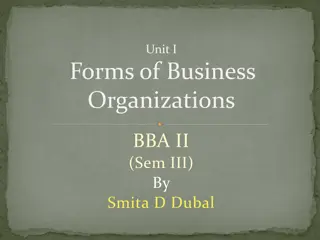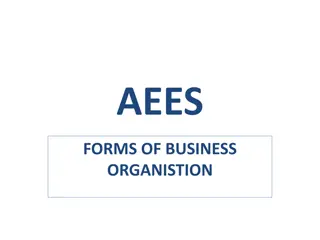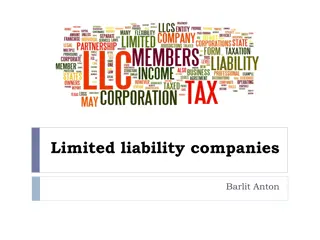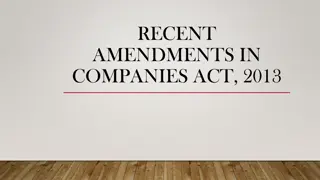Forms of Business Organizations and Types of Companies
Explore the various forms of business organizations, such as Co-operative Society and Joint Stock Company. Learn about their features, merits, limitations, and types, including Consumer Co-operative Societies, Producers Co-operative Societies, and Private/Public Companies. Understand the principles and structures guiding these business entities to make informed decisions.
- Business organizations
- Co-operative Society
- Joint Stock Company
- Types of Companies
- Merits and Limitations
Download Presentation

Please find below an Image/Link to download the presentation.
The content on the website is provided AS IS for your information and personal use only. It may not be sold, licensed, or shared on other websites without obtaining consent from the author. Download presentation by click this link. If you encounter any issues during the download, it is possible that the publisher has removed the file from their server.
E N D
Presentation Transcript
AEES FORMS OF BUSINESS ORGANISTION
Co-operative Society A Co-operative form of business enterprise. In this form the main motive is not earning profit but the main motive of co-operative organisation is mutual help. It work with the principle of each for all and all for each
Features Voluntary membership Legal status Limited liability Control Service motive
Merits Equality in voting status Limited liability Stable existence Economy in operations Support from government Ease of formation
Limitations Limited resources Inefficiency in management Lack of secrecy Government control Difference of opinion
Types of Co-operative Societies Consumer s co-operative societies Producers co-operative societies Marketing co-operative societies Former co-operative societies Credit co-operative societies Co-operative housing societies
Joint Stock Company Definition by Prof Honey. Joint Stock Company is a voluntary association of individual for profit, having a capital divided into transferable shares, the ownership of which is the condition of membership .
Features Artificial person Separate legal entity Formation Perpetual succession Control Liability Common seal Risk bearing
Merits Limited liability Transfer of interest Perpetual existence Scope for expansion Professional management
Limitations Complexity in formation Lack of secrecy Impersonal work environment Numerous regulations Delay in decision making Oligarchic management Conflict in interest
Types of Companies On the basis of ownership the companies can be classified in to following categories (1) Private Company (2) Public Company
Private Company According to the Companies Amendment Act, (2000), a private company is one which Has a minimum of two and maximum of 50 members excluding the employees. Restricts the right of members to transfer their shares. Does not offer its shares to general public. Does not invite general public to invest deposits in the company. Has minimum paid up capit.al of rs. one lakh.
Public Company A public company is the one which Has a minimum of seven members and maximum no limit. Permits easy transfer of its shares. Invites general public to subscribes to its public deposits. Invites general public to subscribes to its shares and debentures. Has minimum paid up capital of five lakh. Any private company which is subsidiary of a public company.
Difference between Private Company & Public Co. Private Co. Public Co. It has minimum 2 and maximum 50 members. It cannot invite general public to buy its shares and debentures. There are certain restrictions on transfer of its shares. It can commence business after incorporation. It has to write Private Ltd. After its name Ex- Tata Sons, Citi Bank, Hyundai Motor India. In its minimum capital required is one lakh. It has minimum 7 and maximum unlimited. It invites general public to buy its shares and debentures. Its shares are freely transferable. It can commence business after obtaining certificate of commencement of business. It has to write only limited after its name Ex- Reliance Industries Ltd., Wipro Ltd. , Raymond s Ltd. In its minimum capital required is five lakhs.
FORMATION OF A COMPANY Formation of a company means bringing a company into existence and starting its business. The steps involved in the formation of a company are: (i) Promotion (ii) Incorporation (iii)Capital subscription (iv) Commencement of business. A private company has to undergo only first two steps but a public company has to undergo all the four stages
Promotion Promotion means conceiving a business opportunity and taking an initiative to form a company. Step in Promotion: 1. Identification of Business Opportunity: The first and foremost function of a promoter is to identify a business idea e.g. production of new product or service. 2. Feasibility Studies: After identifying a business opportunity the promoters undertake detailed studies of technical, Financial, Economic feasibility of a business. 3. Name Approval: After selecting the name of company the promotors submit an application to the Registrar of companies for its approval. 4. Fixing up signatories to the Memorandum of Association: Promotors have to decide about the director who will be signing the memorandum of Association. 5. Appointment of professional: Promoters appoint merchant bankers, auditors etc. 6. Preparation of necessary documents: The promoters prepare certain legal documents such as memorandum of Association, Articles of Association which have to be submitted to the Registrar of the companies.
Incorporation Incorporation means registration of the company as body corporate under the companies Act 1956 and receiving certificate of Incorporation.
Steps for Incorporation 1. Application for incorporation: Promoters make an application for the incorporation of the company to the Registrar of companies. 2. Filing of necessary documents: Promoters files the following documents: (i) Memorandum of Association. (ii) Articles of Association. (iii) Statement of Authorized Capital (iv) Consent of proposed director. (v) Agreement with proposed managing director. (vi) Statutory declaration. 3. Payment of fees: Along with filing of above documents, registration fee has to be deposited which depends on amount of the authorized capital. 4. Registration: The Registrar verifies all the document submitted. If he is satisfied then he enters the name of the company in his Register. 5. Certificate of Incorporation: After entering the name of the company in the register. The Registrar issues a Certificate of Incorporation. This is called the birth certificate of the company.
Capital Subscription: A public company can raise funds from the public by issuing shares and Debentures. For this it has to issue prospectus and undergo various other formalities: Step required for raising funds from public: 1. SEBI Approval: SEBI regulates the capital market of India. A public company is required to take approval from SEBI. 2. Filing of Prospectus: Prospectus means any documents which invites offers from the public to purchase share and Debenture of the company. 3. Appointment of bankers, brokers, underwriters: Banker of the company receive the application money. Brokers encourage the public to apply for the shares, underwriters are the person who undertake to buy the shares if these are not subscribed by the public. They receive a commission for underwriting. 4. Minimum subscription: According to the SEBI guide lines minimum subscription is 90% of the issue amount. If minimum subscription is not received then the allotment cannot be made and the application money must be returned to the applicants within 30 days. 5. Application to Stock Exchange: It is necessary for a public company to list their shares in the stock exchange therefore the promoters apply in stock exchange to list company shares. 6. Allotment of Shares: Allotment of shares means acceptance of share applied. Allotment letters are issued to the shareholders. The name and address of the shareholders submitted to the Registrar
COMMENCEMENT OF BUSINESS: To commence business a public company has to obtain a certificate of commencement of Business. For this the following documents have to be filled with the registrar of companies. 1. A declaration that 90% of the issued amount has been subscribed. 2. A declaration that all directors have paid in cash in respect of allotment of shares made to them. 3. A statutory declaration that the above requirements have been completed and must be signed by the director of company.
Important documents used in the formation of company
Memorandum of Association It is the principal document of a company. No company can be registered without a memorandum of association and that is why it is sometimes called a life giving document. Contents of Memorandum of Association: 1. Name clauses This clause contains the name of the company. The proposed name should not be identicater similar to the name of another exiting company. 2. Situation clauses This clause contains the name of the state in which the registered office of the company is to be situated. 3. Object clause This clause defines the objective with which the company is formed. A company is not legally entitled to do any business other than that specified in the object clause. 4. Liability Clauses This clause limits the liability of the members to the amount unpaid on the shares held by them. 5. Capital clause This clause specifies the maximum capital which the company will be authorized to raise tough the issue of shares called authorized capital.
Articles of Association The articles of Association are the rules for the internal management of the affairs of a company the articles defines the duties, rights and powers of the officers and the board of directors.
Contents of the Article 1.The amount of share capital and different classes of shares. 2. Rights of each class of shareholders. 3. Procedure for making allotment of shares. 4. Procedure for issuing share certificates. 5. Procedure for forfeiture and reissue of forfeited shares. 6. Rules regarding casting of votes and proxy voting 7. Procedure for selection and removal of directors 8. Dividend declaration and payment related rules 9. Procedure for capital readjustment 10. Procedure regarding winding up of the company.
Prospectus Prospectus means any document which invites deposits from the public to purchase share or debentures of a company.
Main contents of the Prospectus 1. Company s name and the address of its registered office. 2. The main object of the company 3. The number and classes of shares. 4. Qualification shares of the directors 5. The name and addresses of the directors, managing director or manager. 6. The minimum subscription which is 90% of the size of the issue. 7. The time of opening and closing of the subscription list. 8. The amt. payable on the application and allotment of each class of share. 9. Underwriters to the issue. 10. Merchant bankers to the issue
Statement is Lieu of Prospectus A public company having a share capital may sometimes decide not to raise funds from the public because it may be confident of obtaining the required capital privately. In such case it will have to tile a statement in lieu of prospectus with the Registrar of companies. It Contains information much similar to that of a prospectus
CHOICE OF FORM OF BUSINESS ORGANISATION 1. Cost and ease in setting up the organization: Sole proprietorship is least expensive and can be formed without any legal formalities to be fulfilled. Company is also expensive with lot of legal formalities. 2. Capital consideration: Business requiring less amount of finance prefer sole proprietorship & partnership form, where as business activities requiring huge financial resonances prefer company form. 3. Nature of business: If the work requires personal attention such as tailoring unit, cutting saloon, it is generally setup as a sole proprietorship. Unit engaged in large scale manufacturing are more likely to be organized in company form.
CHOICE OF FORM OF BUSINESS ORGANISATION 4. Degree of control desired: A person who desires full and exclusive control over business prefers proprietorship rather than partnership or company because control has to be shared in these cases. 5. Liability or Degree of Risk: Projects which are not very risky can be organized in the form of sole proprietorship partnership whereas the risky ventures should be done in company form of organization because the liability of shareholders is limited.

















































